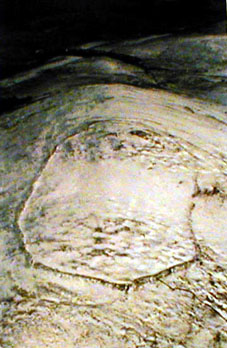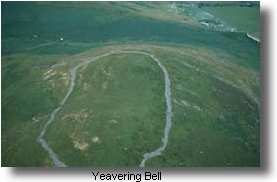Yeavering Bell
 An Iron Age hilltop fort with
a stone rampart in Northumberland, England. In the early 600's the area
between this hill fort and the river Glen (GR NU925306) was the site of
Edwin's Palace, the first Christian earl of the North of England.
An Iron Age hilltop fort with
a stone rampart in Northumberland, England. In the early 600's the area
between this hill fort and the river Glen (GR NU925306) was the site of
Edwin's Palace, the first Christian earl of the North of England.
Yeavering Bell, one of the Cheviot Hills, rises
to 1182 feet The top is encircled by a stone rampart which follows the
contours. The rampart has three entrances enclosing almost fourteen acres.
This is recognised as a large fort for this part of the country. The east
entrance has a protective outer wall whilst the south wall has a guard chamber
on either side.
Aerial photography has revealed the presence
of many circular or oval huts. Outside the ramparts to the west were
a pagan and later Christian temple, a house with a sunken floor (grubenhauser)
a timber ampitheatre, a small building and a timber hall. The timber hall
is almost 100 feet long and about 30 feet wide.
 In 627 St. Paulinus travelled from Kent to
York and Yeavering with Princess Ethelburga of Kent, the daughter of Aethelbert
of Kent (both Christians) to marry them and baptise Edwin.
In 627 St. Paulinus travelled from Kent to
York and Yeavering with Princess Ethelburga of Kent, the daughter of Aethelbert
of Kent (both Christians) to marry them and baptise Edwin.
Edwin was baptised on Easter Day 627 in a specially
built wooden church in York and was thus converted to Christianity
by (St.) Paulinus. We do not know exactly where Edwin's wooden chapel stood
, though there is some likelihood that it was in the pillared square of what
had once been the praetorium or H.Q. building of the Roman fortress
at York, an unambiguous Roman architechtural setting. In the 1970's the
tower of York Minster was strengthened. During this some excavation revealed
that the pillared praetorium was still standing and in good repair
in Edwin's day. At the same time Edwin was baptised, princess Hild, Edwin's
great neice was also baptised by Paulinus.
These baptisms set the stage for the entry of Christianity
into the North of England and united the southern Saxons with the northern
Anglians. A letter was sent from Pope Boniface to Edwin to desist from image
worship.
Bede tells us that Paulinus subsequently spent
thirty-six days at King Edwin's royal residence at Yeavering and was engaged
in non-stop baptism in the nearby river Glen of all who flocked to him.

An artists impession of Edwin's Palace sited
on a natural terrace which slopes down to the river Glen, scene of mass-baptisms
administered by Paulinus.
Aerial photography above the valley of the river
Till, near Wooler in Northumberland revealed in 1948 a complex series of
markings which were initially taken to indicate the remains of a hitherto
unknown monastic settlement. Excavations in the 1950's revealed the site
of Edwin's residence at Yeavering with its associated structures, scene of
the mass baptisms administered by Paulinus.
 Edwin's great hall was an enormous barn-like structure
of timber, with doorways in the long sides "through which a sparrow might
pass from winter darkness to winter darkness" (Bede). The quantities of
cattle bones excavated nearby suggest that the king and his retainers gorged
themselves on beef, washed down no doubt with copious draughts of beer from
generous drinking horns like those found at Taplow or Sutton Hoo. Not far
from the hall there stood a flight of curved benches, rising in tiers and
lengthening as they rose, whose occupants gaze would have focused on a dias
at ground level backed by a massive wooden post.This structure could only
have been designed for seating an assembly which might be addressed from
the dias, rather like a Roman theatre. Did Paulinus address Edwin's warriors
from this dias? Perhaps.
Edwin's great hall was an enormous barn-like structure
of timber, with doorways in the long sides "through which a sparrow might
pass from winter darkness to winter darkness" (Bede). The quantities of
cattle bones excavated nearby suggest that the king and his retainers gorged
themselves on beef, washed down no doubt with copious draughts of beer from
generous drinking horns like those found at Taplow or Sutton Hoo. Not far
from the hall there stood a flight of curved benches, rising in tiers and
lengthening as they rose, whose occupants gaze would have focused on a dias
at ground level backed by a massive wooden post.This structure could only
have been designed for seating an assembly which might be addressed from
the dias, rather like a Roman theatre. Did Paulinus address Edwin's warriors
from this dias? Perhaps.
References;
1. Hope-Taylor, Brian, Yeavering, an Anglo-British
Centre, 1977.
Home
Anglians in in
the North of England.
Copyright © Tim Midgley 1999, revised August
2023.
 In 627 St. Paulinus travelled from Kent to
York and Yeavering with Princess Ethelburga of Kent, the daughter of Aethelbert
of Kent (both Christians) to marry them and baptise Edwin.
In 627 St. Paulinus travelled from Kent to
York and Yeavering with Princess Ethelburga of Kent, the daughter of Aethelbert
of Kent (both Christians) to marry them and baptise Edwin.  An Iron Age hilltop fort with
a stone rampart in Northumberland, England. In the early 600's the area
between this hill fort and the river Glen (GR NU925306) was the site of
Edwin's Palace, the first Christian earl of the North of England.
An Iron Age hilltop fort with
a stone rampart in Northumberland, England. In the early 600's the area
between this hill fort and the river Glen (GR NU925306) was the site of
Edwin's Palace, the first Christian earl of the North of England.

 Edwin's great hall was an enormous barn-like structure
of timber, with doorways in the long sides "through which a sparrow might
pass from winter darkness to winter darkness" (Bede). The quantities of
cattle bones excavated nearby suggest that the king and his retainers gorged
themselves on beef, washed down no doubt with copious draughts of beer from
generous drinking horns like those found at Taplow or Sutton Hoo. Not far
from the hall there stood a flight of curved benches, rising in tiers and
lengthening as they rose, whose occupants gaze would have focused on a dias
at ground level backed by a massive wooden post.This structure could only
have been designed for seating an assembly which might be addressed from
the dias, rather like a Roman theatre. Did Paulinus address Edwin's warriors
from this dias? Perhaps.
Edwin's great hall was an enormous barn-like structure
of timber, with doorways in the long sides "through which a sparrow might
pass from winter darkness to winter darkness" (Bede). The quantities of
cattle bones excavated nearby suggest that the king and his retainers gorged
themselves on beef, washed down no doubt with copious draughts of beer from
generous drinking horns like those found at Taplow or Sutton Hoo. Not far
from the hall there stood a flight of curved benches, rising in tiers and
lengthening as they rose, whose occupants gaze would have focused on a dias
at ground level backed by a massive wooden post.This structure could only
have been designed for seating an assembly which might be addressed from
the dias, rather like a Roman theatre. Did Paulinus address Edwin's warriors
from this dias? Perhaps.